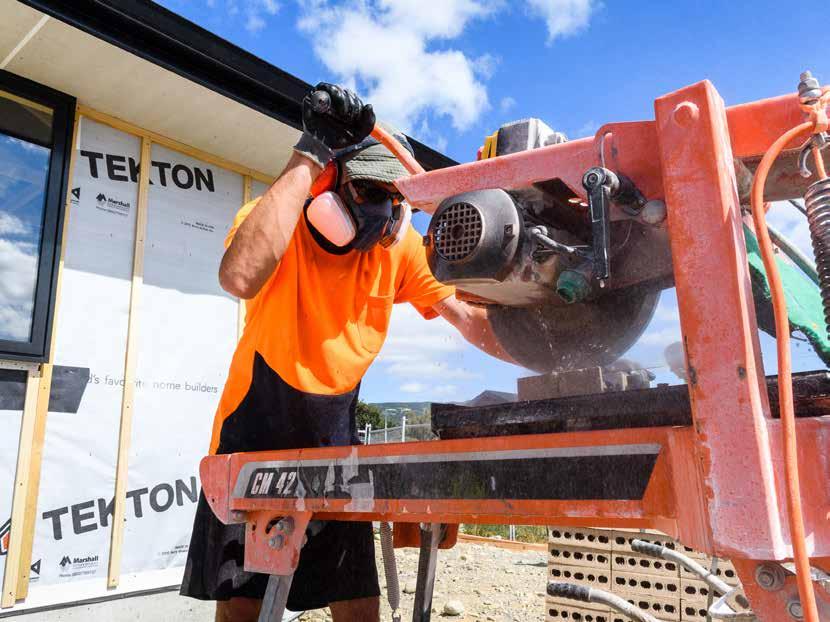
3 minute read
Looking at health and safety from a different angle
Looking at health and safety from a different angle

Airborne contaminants are a serious health risk due to high levels of exposure, particularly in the construction and manufacturing industries. Regularly breathing in airborne contaminants can cause serious damage to your health. Unfortunately, by the time it is noticed, the total damage done may already be serious and life changing.
Recent media activity has drawn attention to the devastating effects of illness caused by airborne contaminants. The stone benchtop manufacturing industry in particular has been in the news in both New Zealand and Australia drawing attention to workers being exposed to high levels of respirable crystalline silica (RCS).
Every person on site is responsible for Health and Safety, it doesn't only sit with the boss. All principal contractors must look after the health and safety of themselves, their workers and anyone who visits their work site. Building contractors and their subcontractors also share this responsibility and must have processes in place to look after the health and safety of their workers and others present on the same worksite.
Where there is more than one contractor working on the same work site, they have a responsibility to work together, sharing safety information and ensuring work is completed safely for all. It is more likely that a business will be successful in this if they:
• Plan ahead, by thinking through every stage of the work, and recognising how the work could affect other businesses and the public
• Identify the health and safety risks that need managing
• Consult with other businesses to agree on how to control each risk
• Consult with other businesses to decide who will control each risk
• Clearly define roles, responsibilities and actions, and explain these so everyone knows what to expect
• Provide appropriate PPE, suited to the task (if necessary)

What can I do?
Where the risk of airborne contaminants cannot be eliminated or the resource cannot be substituted, minimisation controls should be put in place such as:
• Wetting work materials, work processes and work areas with fine water mist
• On tool extraction systems directly at the source
• H class HEPA-filtered vacuum cleaner when cleaning up
• Appropriate respiratory protective equipment which is fit tested to the user
PPE shouldn’t be the first, or only, control measure as it’s the least effective. PPE needs to be suitable for the task and in accordance with the Safety Data Sheet (SDS), such as respiratory protection, hearing protection, overalls, gloves, hard-hat and eye protection. It is a good idea to seek professional advice about the right type of respiratory equipment you need as well as fit and testing.
Know what processes are in place on the site
Airborne contaminants can affect those who are creating the hazard as well as those in close proximity through inhalation, ingestion or absorption. The effects of airborne contaminants are not always instant. Knowing how to manage and minimise the risk is key. The HazardCo App is one tool you can use to regularly perform site reviews to identify hazards and choose the controls that will be put in place. The app also helps you complete toolbox talks where hazards and their controls can be talked about with everyone present on site. The step by step risk assessment feature is perfect for team members and subcontractors as it puts the best practice guides for critical risks in the hands of those who can control them.
Know what you're working with
Knowing the product or material you're working with provides an understanding of the risks involved and how to best manage them. Where products or materials present a health risk ensure the Safety Data Sheet (SDS) and, if applicable, Technical Data Sheets (TDS) are readily available and have been read and understood by those using the resource.
Monitor exposure
Exposure monitoring will confirm whether workers are exposed to a substance at potentially harmful levels and will determine if existing control measures are working effectively. This doesn’t replace the need for other control measures to be in place to reduce exposure.
Monitor worker health
Ongoing health monitoring should be provided to all workers who may be exposed to airborne contaminants. Monitoring should include lung function testing and a respiratory questionnaire.
WorkSafe New Zealand has excellent resources on airborne contaminants in general and silicosis specifically. Check out their resources online if you need more information. If you're a HazardCo member give our advisory team a call!




